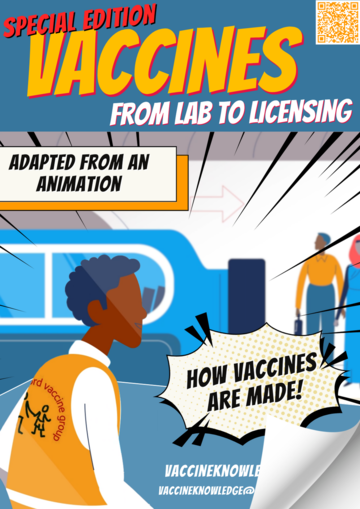|
The standard for testing and monitoring of vaccines is higher than it is for most other medicines because they are one of the few medical treatments given to healthy people - mainly healthy children. This means that the level of acceptable risk is much lower than it might be in some treatments e.g cancer. It can take many years for a vaccine to pass through all the stages described below. In the case of the MenB vaccine, for example, it took 15 years from the first publication of the genome (the complete set of genetic information in an organism) to the vaccine being licensed for use. There are various stages that a vaccine must go through before use. These include;
Research and development: This stage begins with reviewing the work that other scientists have done before. Once this has been fully explored, the development of a new idea can begin. Scientists will either come up with a new idea completely or will make changes to an existing idea. Then the laboratory work can begin. Initially, the vaccine is tested on cells - this is called ‘in vitro’ testing. Then, vaccines are tested on animals, often mice. This is called ‘in vivo’ testing. The vaccine must pass these rigorous safety tests in this stage and demonstrate that the vaccine can cause an immune response in animals before moving on to the next stage.
Phase 1: This is the initial stage of testing a vaccine in humans and involves a small group of adult participants, usually up to 100 people. This is carried out to make sure that the vaccine does not have major safety concerns in humans and to work out the most effective dose.
Phase 2: The next stage involves a larger group of participants, usually several hundred people, and may be from the target population. This stage checks that the vaccine works consistently, and scientists look at the immune response created by the vaccine. Doctors also start looking for potential side effects of the vaccine.
Phase 3: The final stage of testing is in a much larger group of people, usually several thousand. Phase 3 trials gather information on how well the vaccine has worked in humans (sometimes called the vaccine's efficacy), and the vaccine's safety. In Europe, more than 3000 participants are usually needed for the safety assessment before it can be licensed. This means looking at whether the vaccine generates a level of protection that would prevent disease and provides evidence that the vaccine can either reduce the number of cases of that disease or reduce the harm caused by the disease to the individual. It also gives a better chance of identifying rarer side effects not seen in the phase II study.
Human challenge model: Sometimes, a ‘controlled human infection model’ (CHIM) is used to speed up the development of a vaccine. This type of carefully controlled study is where a healthy, fully consenting volunteer is deliberately infected with a disease, usually to test how well the vaccine works. The volunteer is then monitored very closely, and if they become symptomatic, they are offered an effective treatment. This is usually carried out during phase 2 or phase 3 of a clinical trial and can speed up the lengthy process of developing a vaccine.
|




